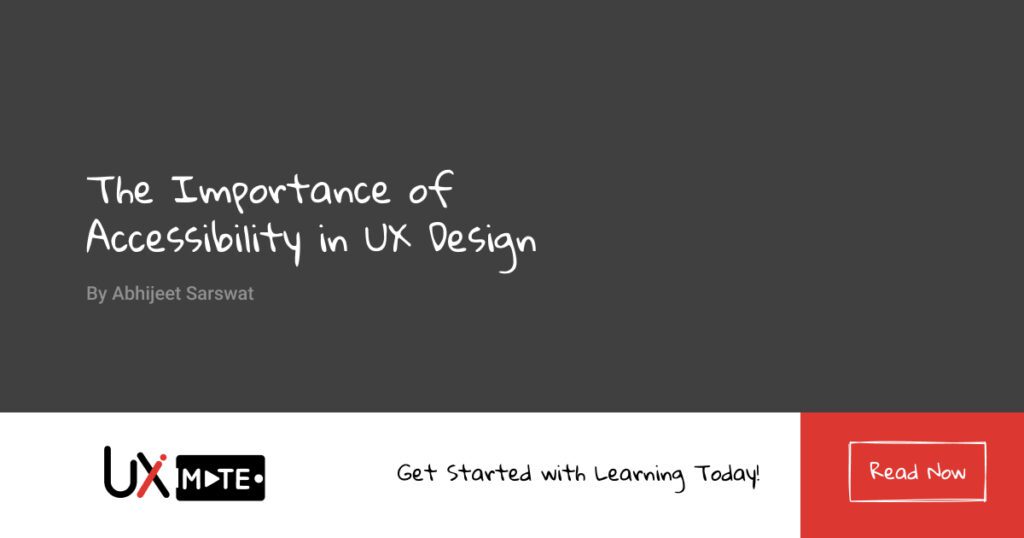In the ever-evolving world of user experience (UX) design, crafting solutions that seamlessly connect with diverse audiences stands as the ultimate aim. The cornerstone of user-centered design dictates that interactions should be effortless, tasks should be achievable, and experiences should be meaningful for all. Yet, this aspiration presents a labyrinth of challenges. Enter the concept of accessibility in UX design—a beacon of equity and usability that redefines how we approach design with empathy and inclusivity.

In the ever-evolving world of user experience (UX) design, crafting solutions that seamlessly connect with diverse audiences stands as the ultimate aim. The cornerstone of user-centered design dictates that interactions should be effortless, tasks should be achievable, and experiences should be meaningful for all. Yet, this aspiration presents a labyrinth of challenges. Enter the concept of accessibility in UX design—a beacon of equity and usability that redefines how we approach design with empathy and inclusivity.
The Heartbeat of Accessibility
At its core, accessibility in UX design embodies a philosophy that extends beyond special needs and delves into the essence of utility and usability for everyone. It transcends mere responsiveness and interaction to encompass the nuanced requirements and contexts of varied users. Whether users possess distinctive abilities, face cognitive hurdles, or navigate unique settings, accessibility ensures their seamless engagement with the product or service.
In today’s organizational landscape—spanning across UI/UX design services companies and beyond—embracing accessibility isn’t merely an option; it’s imperative. By embracing designs that cater to all and fostering equal access, businesses extend their reach to broader horizons. This is particularly palpable in the realm of web pages and mobile applications, where the emergence of accessibility statements underscores the commitment to delivering inclusive digital experiences.
Unraveling the Depth
Accessibility in UX design is a tapestry that reaches beyond catering to individuals with specific needs. It encompasses a multi-dimensional approach that accounts for varied facets, from physical requisites to contextual scenarios. For instance, navigating a GPS app while driving isn’t a uniform experience—it shifts based on physical capabilities and environmental factors. Accessibility isn’t restricted to a single dimension; it’s a holistic narrative that embraces every user’s reality.
In the context of UX design, accessibility entails ensuring that each member of the target audience can seamlessly access the product or service. It extends beyond usability to encompass practicality and adaptability across different scenarios, catering to the myriad needs of users. To achieve this, UX designers adopt a set of principles that cater to every individual, forging designs that stand as paragons of inclusivity.

Beyond Usability: The Aura of Accessibility
Though accessibility and usability often intertwine, they bear distinct significance. Usability zeroes in on effectiveness, responsiveness, and overall satisfaction. On the other hand, accessibility elevates design to a realm of purpose, ensuring that special needs are accounted for and that every member of the audience enjoys an equitable experience.
Accessibility is a driving force that champions parity among users, regardless of their physical or cognitive attributes. It ensures that the needs of all target customers are foregrounded, fostering a design ethos that transcends constraints. Users with diverse ability levels should relish equivalent satisfaction, and this principle forms the bedrock of accessibility in UX design.
In the Epilogue
The potency of accessibility in UX design rests in its capacity to dismantle barriers and foster designs that embrace an expansive array of users. By incorporating accessibility, organizations can create products and services that not only fulfill user requisites but also leave a profound imprint on their lives. The journey toward accessibility is a perpetual one, marked by an unwavering pledge to comprehend users at a profound level and craft designs that resonate with the tenets of inclusivity and usability. Amidst the dynamic expanse of design, accessibility emerges as a guiding light, illuminating our way toward a future that’s richer in inclusivity and empathy.
Read more about The Importance of Accessibility in UX Design


Pingback: The Power of UX Heuristic Evaluation -
Pingback: Conversation Design - 7 Principles and Best Practices - UX Mate